Working with Workflows
Workflow annotation projects are projects which have been created using Workflows (Beta). Click here to learn about creating and configuring Workflow projects.
Project dashboard
Clicking on a project in the 'Projects overview' screen takes you to its 'Project dashboard'.
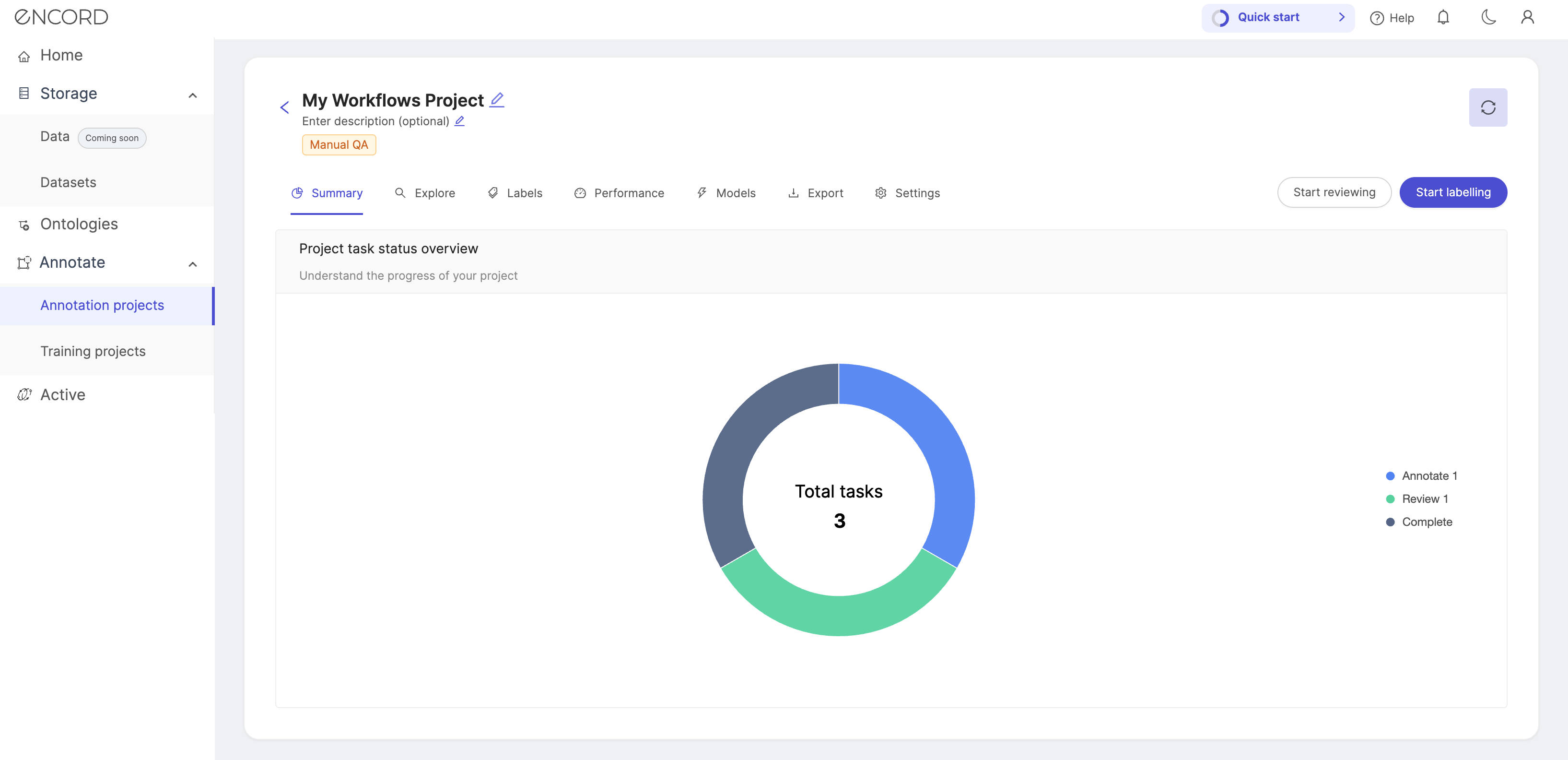
This is where you monitor and manage your project - view your project's summary statistics, manage labeling tasks, view your team's productivity, train models and invite collaborators.
The dashboard is split into 7 tabs:
- Summary: a high-level view of labeling and productivity statistics.
- Explore: a quick way to explore the distribution of instances and labels across data assets in the project.
- Labels: for managing all the project's labeling activity and tasks.
- Performance: a more detailed view of your team's manual labeling and productivity.
- Models: for creating, training and using pre-trained computer vision models with your labeled training data.
- Export: for exporting your labeling data.
- Settings: editing project options, ontology, team collaborators, and other general project settings.
Summary
Clicking a workflow project takes you to its summary dashboard. This dashboard has 2 components and gives you a rich visual display of your project's progress at a high level.
Project task status overview
Displays the number of tasks that are in each state of your workflow project. The number of states and their names reflect the choices made during workflow project creation.
Click on the stages in the chart key to remove, or include them from the donut view
Explore
The 'Explore' tab helps you understand how project annotations are distributed among data assets, at both an instance and label level. It allows a deeper exploration through nested classifications on objects, as well as frame-level classifications.
- Instance statistics: Class distribution across data assets in the given project.
- Label statistics: Label distributions within data assets, objects and classifications.
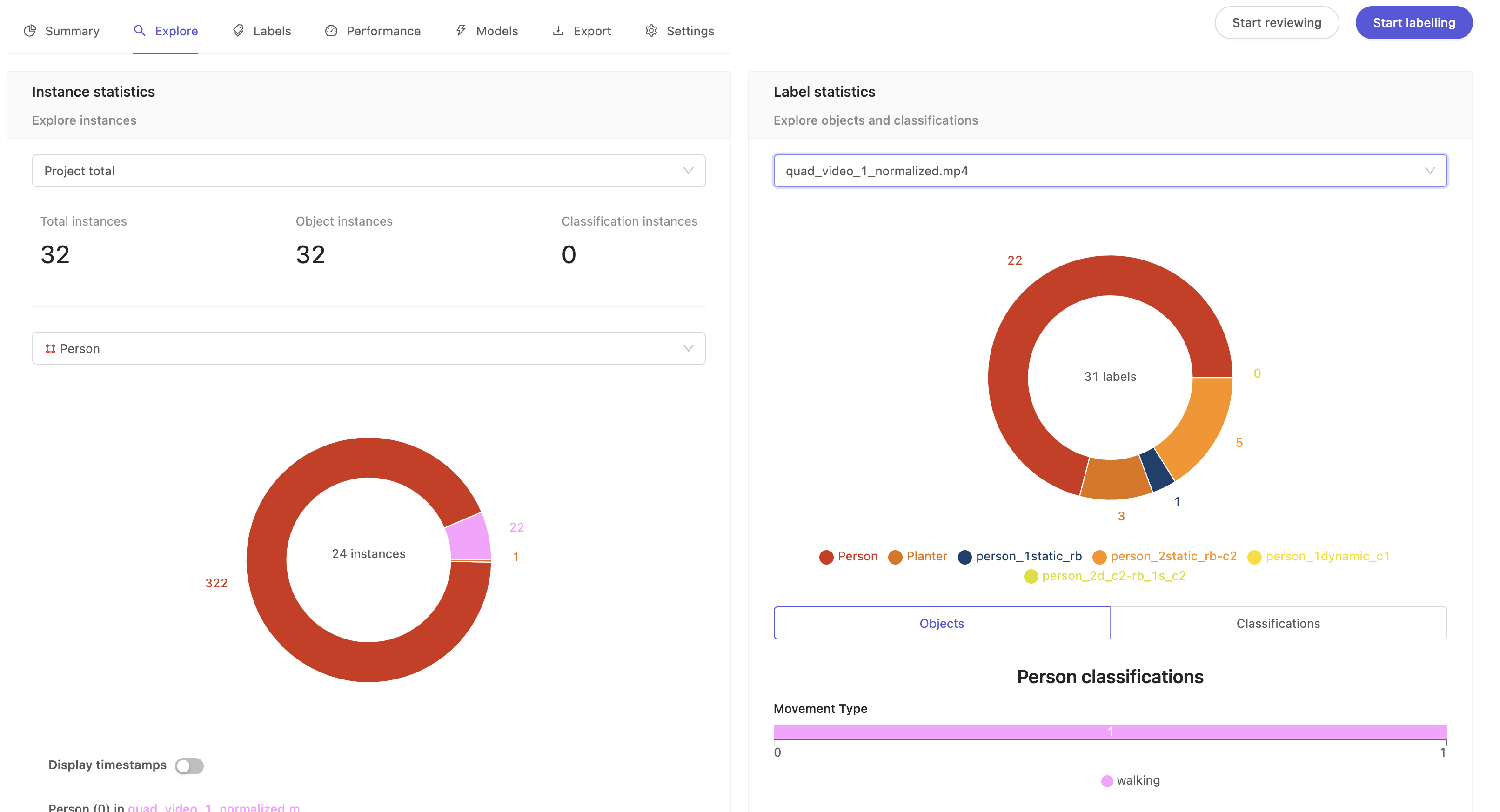
Instance statistics
This section provides the total count of all instances across the datasets in your project.
- Project total: Shows total instances (both objects and classifications) across the project by default. To get instance statistics for individual data files, click the dropdown to select a data file.
- Select class: Shows the total instances for a particular class. This is a summary of how a given class is distributed across your project's data assets. The pie chart segments show a breakdown of how that class is split across the data assets.
- Display timestamps: Flip the toggle to switch between frame numbers and timestamps for the labels.
Label statistics
This is a summary of how your labels are distributed across the project. The pie chart shows a breakdown of how many labels there are for a given class.
- Project total: Shows the total number of labels across different datasets in the project. To get label stats for individual data files, click the dropdown to select a data file.
- Objects: Click on the pie chart segment of a class to see the total number of labels and its nested classifications (sometimes called nested attributes) if available for that class.
- Classifications: Shows the global classification at project or individual video level. For example, location, time of day, etc.
Quick definitions of classes, instances and labels
- Class: Fundamental unit of the project's ontology. For example the ontology of a project annotating traffic videos could have classes such as Car, Truck, Bicycle, and so on. For more information on objects and classifications, see Ontologies Overview.
- Instance: Specific occurrence of a class. Car(0) is an instance of the Car class, for example, it could be a specific black sedan. The single Car(0) instance can appear in a single frame or a range of frames. Therefore, instances may contain multiple labels across frames.
- Label: An frame-specific annotation of an instance. For example the annotation of Car(0) on frame 201 is a label.
Labels
The labels tab is your gateway to annotating and auditing the labels made against all the datasets in your project.
Tasks can only be assigned to collaborators that have been added to the workflow stage a task is currently in. Find out more in our section on managing collaborators.
Access to each pane will depend on the user's project role. We quickly summarize the purpose of each tab, and the roles which can access each below.
| Role | Activity | Queue | Data | Instances |
|---|---|---|---|---|
| Annotator | X | X | ||
| Team Manager | X | X | X | X |
| Admin | X | X | X | X |
The labels dashboard features the following tabs:
- Data activity: An overview of all data assets in the project as well as their task status.
- Queue: The Queue tab is where all labeling is initiated, regardless of a user's role within the project. It pulls tasks from the workflow, therefore ensuring collaborators' efforts don't overwrite each other.
- Instances: The Instances tab lets you use the unique instance identifier to search the project for a specific instance, and jump directly into the editor to confirm the status of an annotation visually.
Activity
The activity screen allows you to quickly monitor annotation and review activity in your project by showing tasks and providing a summary interface to see the status of reviewed labels inside each task. Tasks are displayed in most recently edited order from top to bottom.

- A. File, Search, & Reopen: The name of the specific data unit or data asset. This is the same as the name in the dataset to which this data asset is a part of. Use the search box to filter the list by file name, and send tasks back to annotation using the 'Reopen' feature.
- B. Dataset: The dataset the data asset belongs to.
- C. Type: The type of the data, such as an image or video. For more on our supported data types, see our documentation here.
- D. Status: The status of this task within the workflow.
- E. Frames: The number of frames in the data asset. For a DICOM series, this will be the number of slices.
- F. Reviews: How many annotation instances are in this data asset.
- G. Submitted: Indicates when the last submit action, whether for an annotation or review, was made against any of the labels in this data asset.
- H. Submitted by: Who last submitted the annotations.
- I. Reviewed by: Who submitted the most recent review.
- J. Actions: Click the 'View' link to open the label editor. Note: this feature is only available to Team Managers and Administrators as an extra method of reviewing submissions. We advise extra caution if you decide to edit the labels from this interface. If significant work needs to be done, we strongly recommend to 'Reopen' the task to prevent possible errors from simultaneous edits.
- K. Filter: Use the filter dropdown to only show tasks with the selected status.
File, Search, and Reopen
The file column shows the name of the data asset. For files uploaded via the GUI, they keep the name they were uploaded with. For files added from your cloud storage, this will normally be the path under the bucket they are stored on.
Use the search interface to quickly filter and display only those tasks with file names matching your desired text. Even partial matches will be shown. For example: searching "fly" will return file names containing "flyover" and "flyaround."
The 'Reopen' button allows Administrators and Team Managers to send Completed tasks back to annotation. Select your target tasks using the checkboxes in the File column to select individual assets, or select the checkbox in the column header to select all tasks, and press the 'Reopen' button to move all selected tasks back to the annotation stage. Tasks reopened in this way will have the status 'Returned,' in the 'Queue' tab. No labels are lost by reopening a task. The 'Reopen' action is only applied to tasks which are both visible (i.e. not filtered out by the file search) and selected.
Tasks can be 'Reopened' from all stages using the Encord SDK. Please see the relevant documentation here.
Status
This column shows the status of this task within the workflow. The Activity pane only shows assets which have had some action done on them, and therefore only reflects tasks with the following statuses:
- In review: The annotation task has been submitted but outstanding review tasks remain. In review task status is shown in blue.
- Completed: The annotation task has been submitted and all reviews have been completed. Completed task status is shown in green.
For a comprehensive summary of the possible task states, see the status section of the Data tab below.
Reviews
The 'Reviews' column shows a count of how many instances have been reviewed in a given data asset. Click the number to open a panel which shows the last review action taken on each instance, as well as who originally created the annotation and when. Note that unless the review was done by an 'Expert Reviewer', all reviewed annotations must be either 'Approved' or 'Deleted' before a task can be 'Completed.' Read more about the Expert Review feature here.
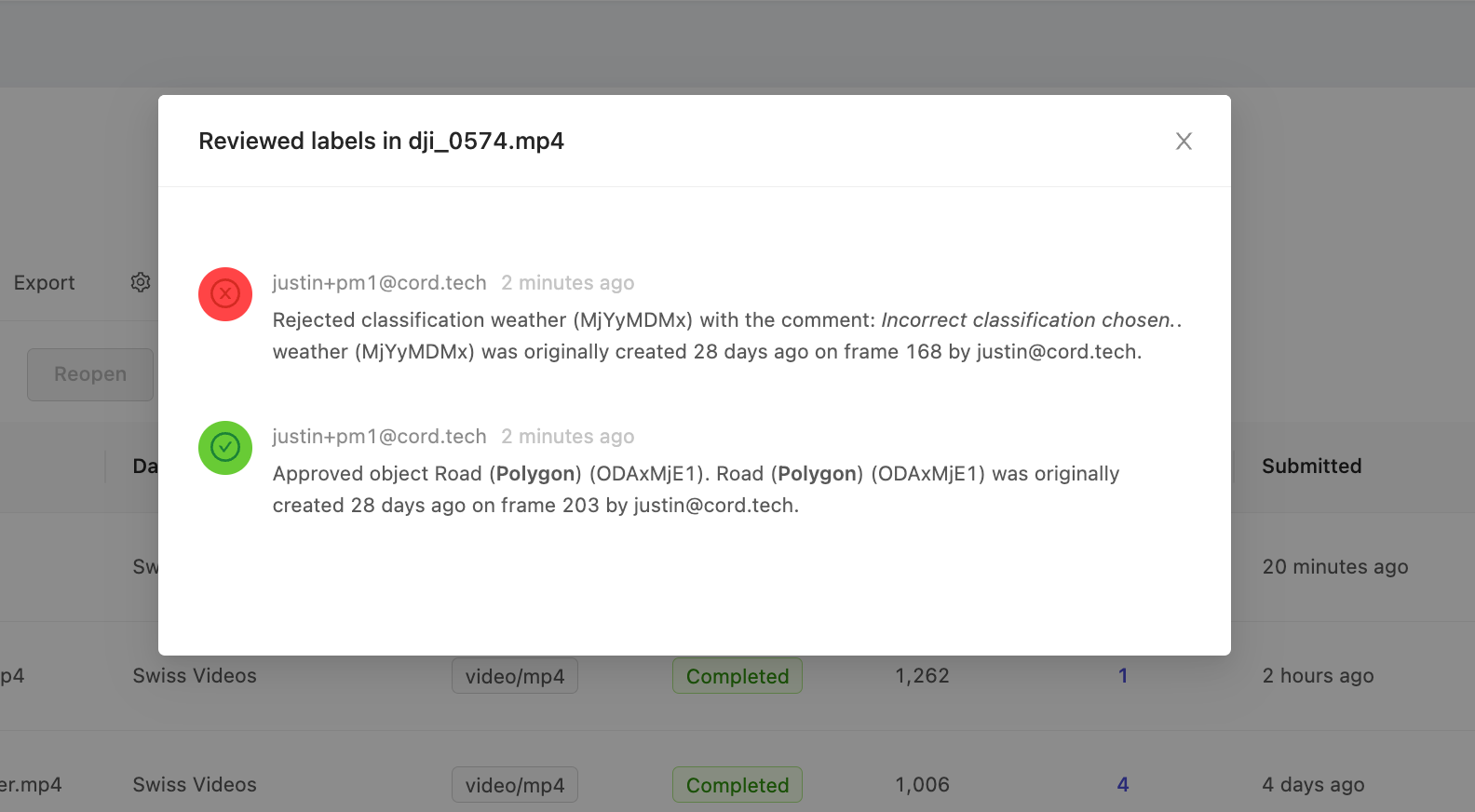
Queue
The 'Queue' is where annotators and reviewers look to find their next task. The 'Start labeling' and 'Start reviewing' buttons visible throughout the project open the label editor with the next task in the queue according to the relevant task type. This tab can be used to assess the number of tasks assigned to you as an annotator or reviewer and therefore estimate your likely workload. Administrators and Team Managers can also use it to quickly verify the current assignments per team member, and change assignments as necessary.
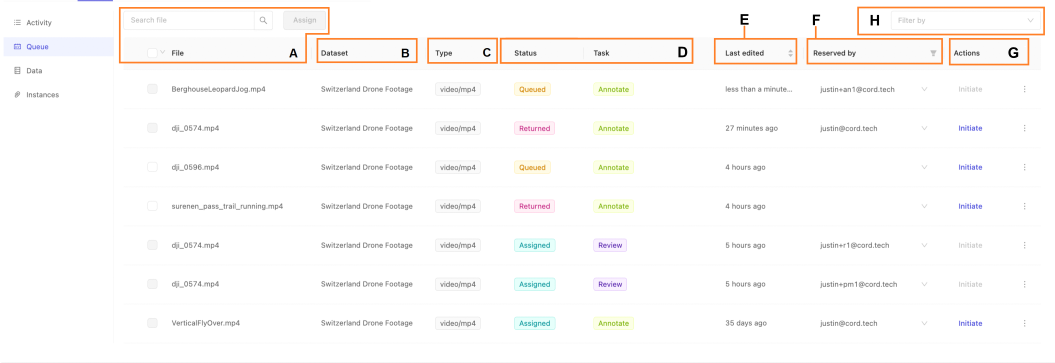
- A. File, Search, & Assign: The name of the specific data unit or data asset. This is the same as the name in the dataset to which this data asset is a part of. Use the search box to filter the list by file name, and send tasks back to annotation using the 'Reopen' feature.
- B. Dataset: The dataset the data asset belongs to.
- C. Type: The type of the data, such as an image or video. For more on our supported data types, see our documentation here.
- D. Status and Task: The status and category of this task within the workflow.
- E. Last Edited: When the task was last edited.
- F. Reserved by: Who the task has been assigned to or reserved by.
- G. Actions: Depending on your collaborator role, you can initiate or reassign the task.
- H. Filter: Use the filter drop-down to only show tasks of the selected status.
File, Search, and Assign
The file column shows the name of the data asset. For files uploaded via the GUI, they keep the name they were uploaded with. For files added from your cloud storage, this will normally be the path under the bucket they are stored on.
Use the search interface to quickly filter and display only those tasks with file names matching your desired text. Even partial matches will be shown. For example: searching "fly" will return file names containing "flyover" and "flyaround."
The 'Assign' button allows Administrators and Team Managers to allocate unassigned tasks to specific collaborators for annotation or review. Select your target tasks using the checkboxes in the File column to select individual assets, or select the checkbox in the column header to select all tasks, and press the 'Assign' button open the task assignment popup. Confirm the selected tasks are as intended, then select the target collaborator from the dropdown and press assign. Tasks which have already been assigned to another collaborator, as indicated by the email in the 'Reserved by' column, can not be reassigned until they have first been released.

Status and Task
The 'Queue' tab only shows tasks which have remaining annotation or review work to be done within the workflow. Therefore, the stage of the task within the workflow is understood by reading the Status and Task columns together.
The two types of tasks are 'Annotate' and 'Review' which can be in any of the following states:
- Queued: The task is ready for annotation or review. For an annotation tasks to be 'Queued' it must not be assigned to a user, and must have no submitted labels. It may have been previously assigned to a user, but subsequently released before any annotations were submitted.
- Assigned: The annotation or review task is assigned to a specific user.
- Returned: The annotation task was previously submitted, and either several of the annotations were rejected by the reviewer or it was 'reopened' after completion by a Team Manager or Administrator.
Actions
There are two relevant actions that can be done on each task from the 'Queue' pane. Press 'Initiate' to open the label editor and proceed with annotation or review, depending on the task type.
Additionally, Administrators and Team Managers can click the three vertical dots to open the expanded menu, to access the 'Release task' function. Tasks must be explicitly released before they can be reassigned.
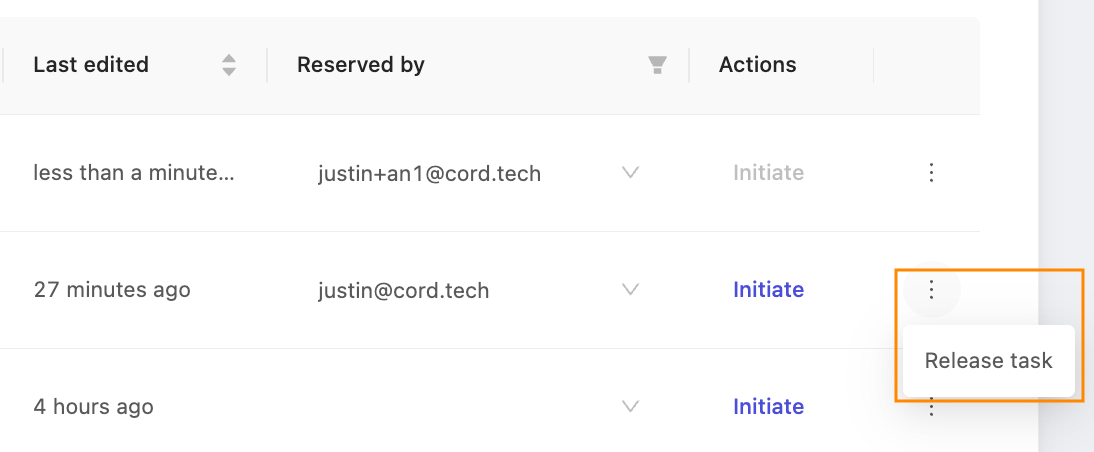
Data
The Data tab gives a complete overview of all the data asset tasks in the project, regardless of their progress through the project's workflow. Therefore, this is the first place where Administrators and Team Managers should check if they want to confirm the status of a given task.

- A. File & Search: The name of the specific data unit or data asset. This is the same as the name in the dataset to which this data asset is a part of. Use the search box to filter the list by file name.
- B. Dataset: The dataset the data asset belongs to.
- C. Type: The type of the data, such as an image or video. For more on our supported data types, see our documentation here
- D. Status: The status of this task within the workflow.
- E. Frames: The total frames in this data asset. This will apply to videos, image sequences and DICOM. Images always only have 1 frame.
- F. FPS: the frames per second of the data asset. This only applies for data of type video. Others will show a dash (
-). - G. Created: When the task was created. Tasks are created when the dataset containing the data asset is attached to the project.
- H. Last edited by: the last collaborator who edited the task in any capacity (such as annotate or review), and when.
- I. Actions: The 'Data' tab allows users to view the task in the label editor, as well as get a code snippet for using the SDK with this task, and confirming the edit actions via the Activity Log.
- J. Filter by: Use the filter dropdown to view only tasks with the selected Status.
File and Search
The file column shows the name of the data asset. For files uploaded via the GUI, they keep the name they were uploaded with. For files added from your cloud storage, this will normally be the path under the bucket they are stored on.
Use the search interface to quickly filter and display only those tasks with file names matching your desired text. Even partial matches will be shown. For example: searching "fly" will return file names containing "flyover" and "flyaround."
Status
The data tab provides the most comprehensive overview of all the tasks associated with each data asset in a given project. As such, this is the first place to check to see the status of various tasks.
- Queued: The task is ready for annotation. For a task to be 'Queued' it must not be assigned to a user, and have no submitted labels. A queued task may have been previously assigned to a user, but subsequently released before any annotations were submitted. Queued tasks are shown in light orange.
- Assigned: An annotation task has been assigned to a specific user. Assigned tasks are shown in aqua green.
- In review: The annotation task has been submitted but outstanding review tasks remain. In review task status is shown in blue.
- Returned: The task was previously submitted, and either several of the annotations were rejected by the reviewer or it was 'reopened' after completion by a Team Manager or Administrator.
- Completed: The annotation task has been submitted and all reviews have been completed. Completed task status is shown in green.
Actions
Clicking View will drop you into the label editor to do a live audit of the annotations in this data asset. The 'Data' tab is only visible to Administrators and Team Managers and so grants great power to view any data asset, however appropriate care must be taken to ensure annotations are not simultaneously edited from the 'Queue' pane by an annotator or reviewer. Encord advises edit actions are NOT taken from the Data tab unless you have received confirmation no one else is concurrently editing the asset.
In order to prevent any possible issues of annotator work being overwritten, it's critical that all annotations are done via the workflow's Queue tab, and only the person assigned to the task makes annotations at any given time.
Other possible actions include 'API Details' which show a popup with sample code you can use to get started with our SDK to access this particular data asset, often known as a label row in the SDK. Click Activity log to see a popup with a graphical summary of add / edit / delete actions on this data asset indexed by annotator or ontology class. Click Display logs in the lower right to show all actions in reverse chronological order.
Instances
The 'Instances' tab allows Administrators and Team Managers to search within the data to directly find specific instances. Recall that an annotation instance correlates to a unique instantiation of a specific ontology class in a data asset. For example, if you have the 'Person' class in your ontology, the first instance of a 'Person' in a given data asset will be indicated in the interface as 'Person (0)', the second as 'Person (1)' and so on. Instances, therefore, can exist in multiple frames of a data asset, and indicate the same object. Use the 'Instances' tab to search for specific instances of objects or classifications using their Identifier.

Instance identifiers are unique at the project scope, and can be found in any of the following ways:
- From inside the label editor, by clicking on a particular instance, and then selecting 'Copy identifier' from the instance action menu.
- From inside exported labels, where they are known as the
objectHashorclassificationHashas appropriate. - When uploading labels using the SDK, you may specify your own
objectHashorclassificationHash.
Once you have an identifier of interest, use the 'Search instance' interface to filter the instances by identifier to quickly find the instance you're interested in. This can be particularly handy when you want to visually confirm an annotation you may not have seen before, but for which you have the identifier.
After locating your instance of interest, click View from the 'Actions' column to jump deeply into the dataset straight to where the instance is first annotated.
Performance - Summary
The 'Summary' tab of the performance dashboard provides an overview of your team's manual labeling and productivity. You're able to switch between a summary, or detailed view of performance metrics using the toggle found at the top of the 'Performance' tab.

Task actions over time
View the number of tasks in a project that have been approved, rejected, and submitted for review over a given period of time.
- The height of a bar represents the total number of tasks.
- The height of each color within a bar represents the number of approved, rejected, and submitted tasks.
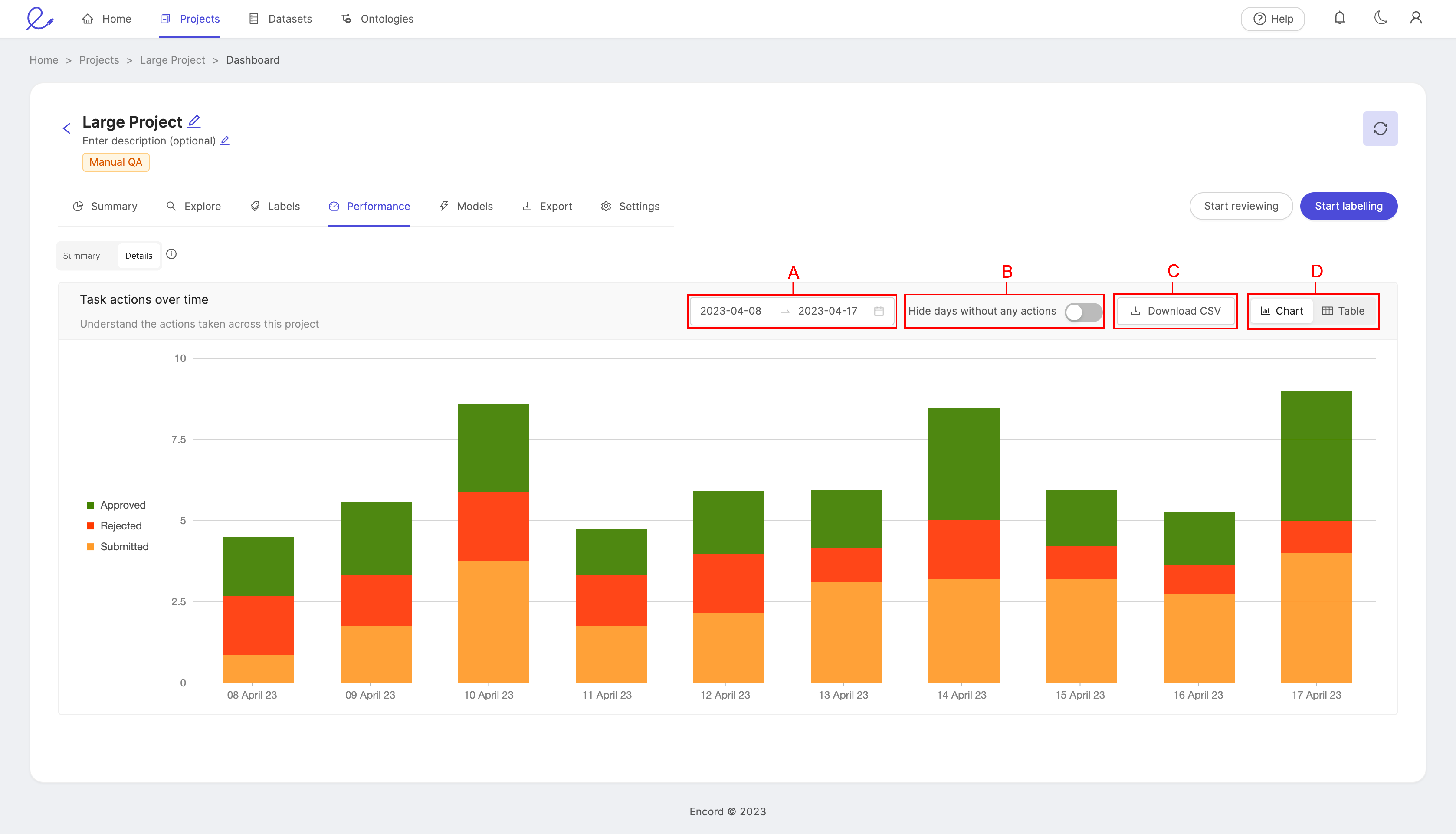
- A: Set the time period you would like to see displayed by selecting a range of dates.
- B: The Hide days without any actions toggle removes all days at which no actions were taken from the view.
- C: Download a CSV file of the data.
- D: Display the data as a bar chart, or a table. While the chart provides a clear visual representation, the table provides exact figures for a more detailed picture of your team's performance.
Instance Label actions over time
View the number of instance label actions in a project that have been approved, rejected, and submitted for review over a given period of time.
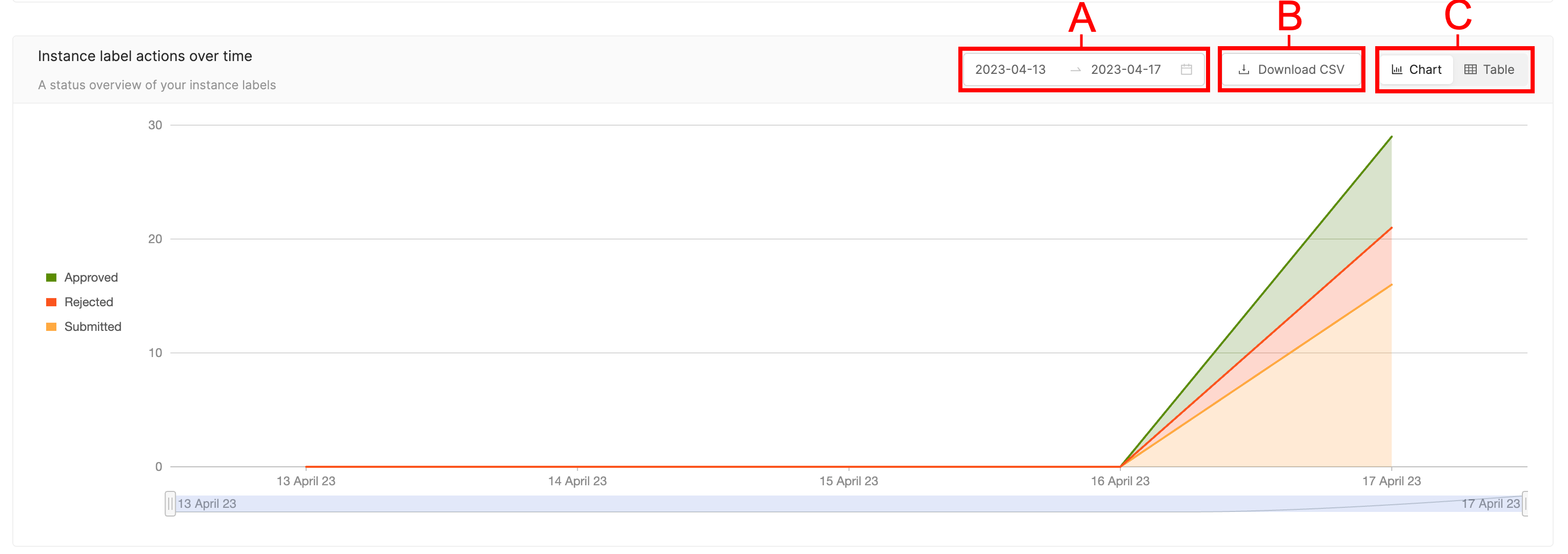
- A: Set the time period you would like to see displayed by selecting a range of dates.
- B: Download a CSV file of the data.
- C: Display the data as a bar chart, or a table. While the chart provides a clear visual representation, the table provides exact figures for a more detailed picture of your team's performance.
Within your specified time period, you can choose which dates to display by using the slider located beneath the graph.
Team collaborators
The 'Team collaborators' section the duration of time each project collaborator spend working on a given file.

A. 'Data file' displays session time collaborators spent working on individual files. 'Project' displays session time collaborators have spent working on the project.
B. Table entries can be filtered according to dates by clicking the range of dates, and selecting the start and end date of the period you would like to see table entries displayed for.
C. Table entries can be downloaded in CSV format by clicking the Download CSV button.
D. When lots of entries are present they will be split across a number of different pages. The number of table entries per table can be adjusted.
Performance - Details
The 'Details' tab of the performance dashboard gives a more detailed view of your team's manual labeling and productivity. You're able to switch between a summary, or detailed view of performance metrics using the toggle found at the top of the 'Performance' tab.

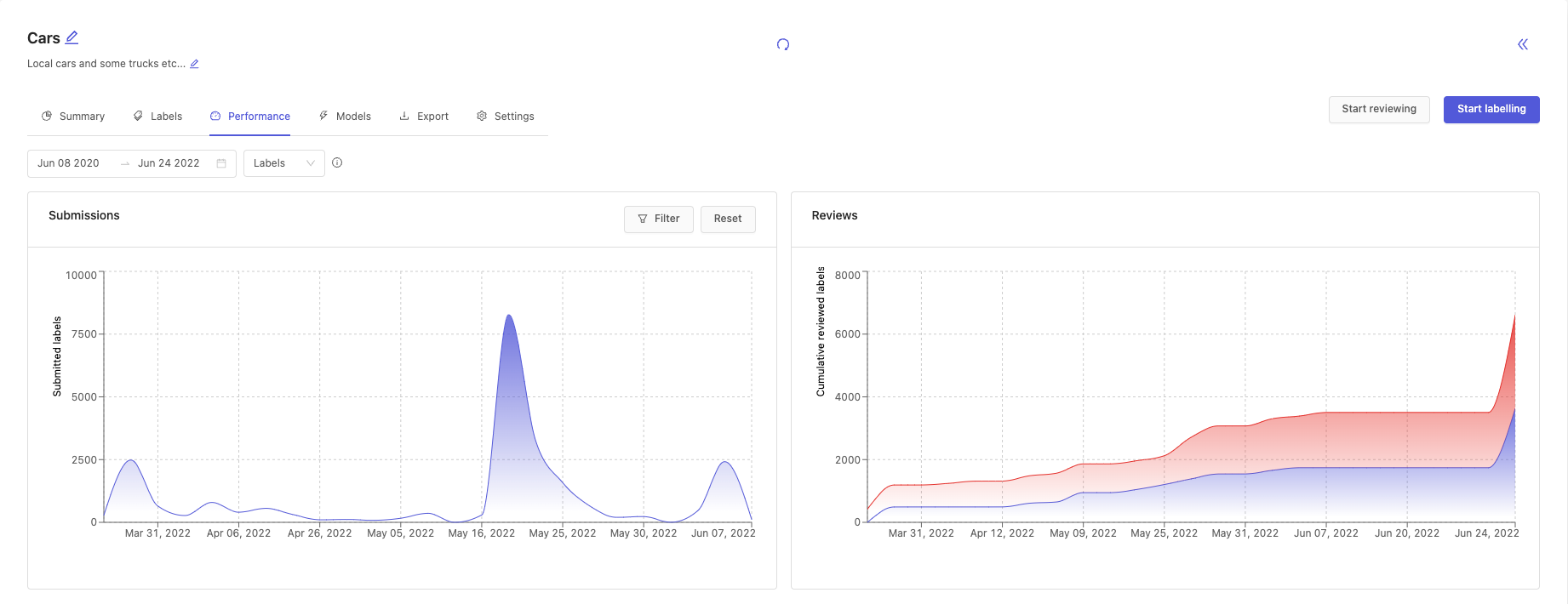

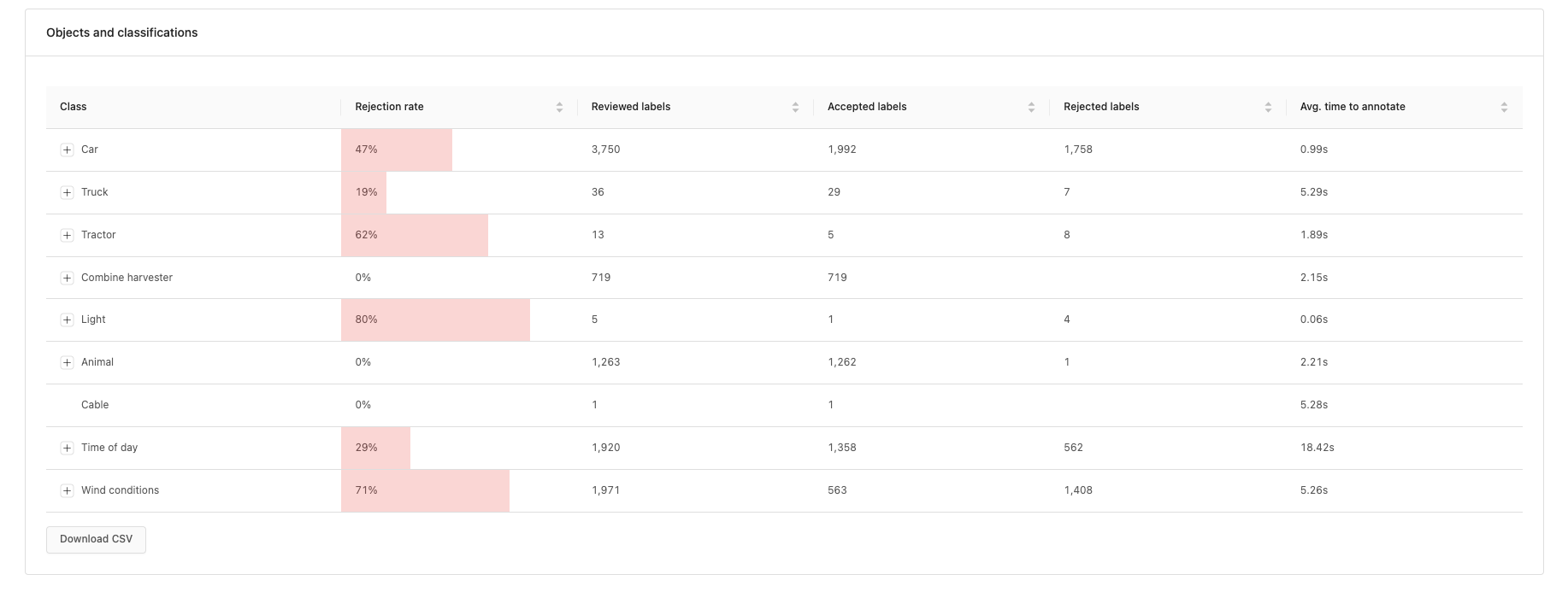
There are two global filters that can be applied to the entire dashboard:
- Date range: sets the date boundaries for the statistics shown on the dashboard.
- Labels or instances: how your labels are distributed across datasets, objects and classifications.
- More information here.
Models
Models are top-level entities that can automate labeling in a variety of use cases.
Please see our documentation on models to learn how to create, train, and attach different models to projects.
Export
The 'Export' tab is where you export the labels created in a project.

A. Select the files you'd like to export data for by clicking the checkboxes next to the files you'd like to include in your export. Click Export to export the selected data.
B. Select which the format of the exported label data; COCO or JSON.
C. Toggle this switch if you'd like to include signed URLs in your export.
D. Select the label status of the annotations you would like to be included in the data export.
E. Select the objects you would like to include in the data export.
F. Select which classifications to include in the data export.
Export data from the Encord web app
Click the Export to start the export process. Depending on the number of labels, this process may take a few minutes to complete.
The progress can be monitored using the ![]() icon in the top-right of the page. This is where you'll be notified when the process has completed.
icon in the top-right of the page. This is where you'll be notified when the process has completed.
Download files are tagged with a unique id for the project they're exported from and the time at which the export is made.
Label export history
Export history is tracked per file per request, regardless if the request was made via the web app or the SDK,
or if the format was COCO or Encord's JSON format. Currently, you can confirm the export history for a given
file by exporting it from the web app in Encord's JSON format. Export the labels like normal and look for the
export_history key inside each label object. Note that the act of exporting labels to confirm export history
will also generate an export history entry.
Export data using the Python SDK
Look here to learn how to export JSON files from Encord's Python SDK. Please reach out to us to request for exporting COCO labels.
Workflow
The 'Workflows' tab is where you adjust the settings of individual workflow stages:
- Adding or editing webhooks.
- Managing project level collaborators.
- Managing collaborators within a workflow stage.
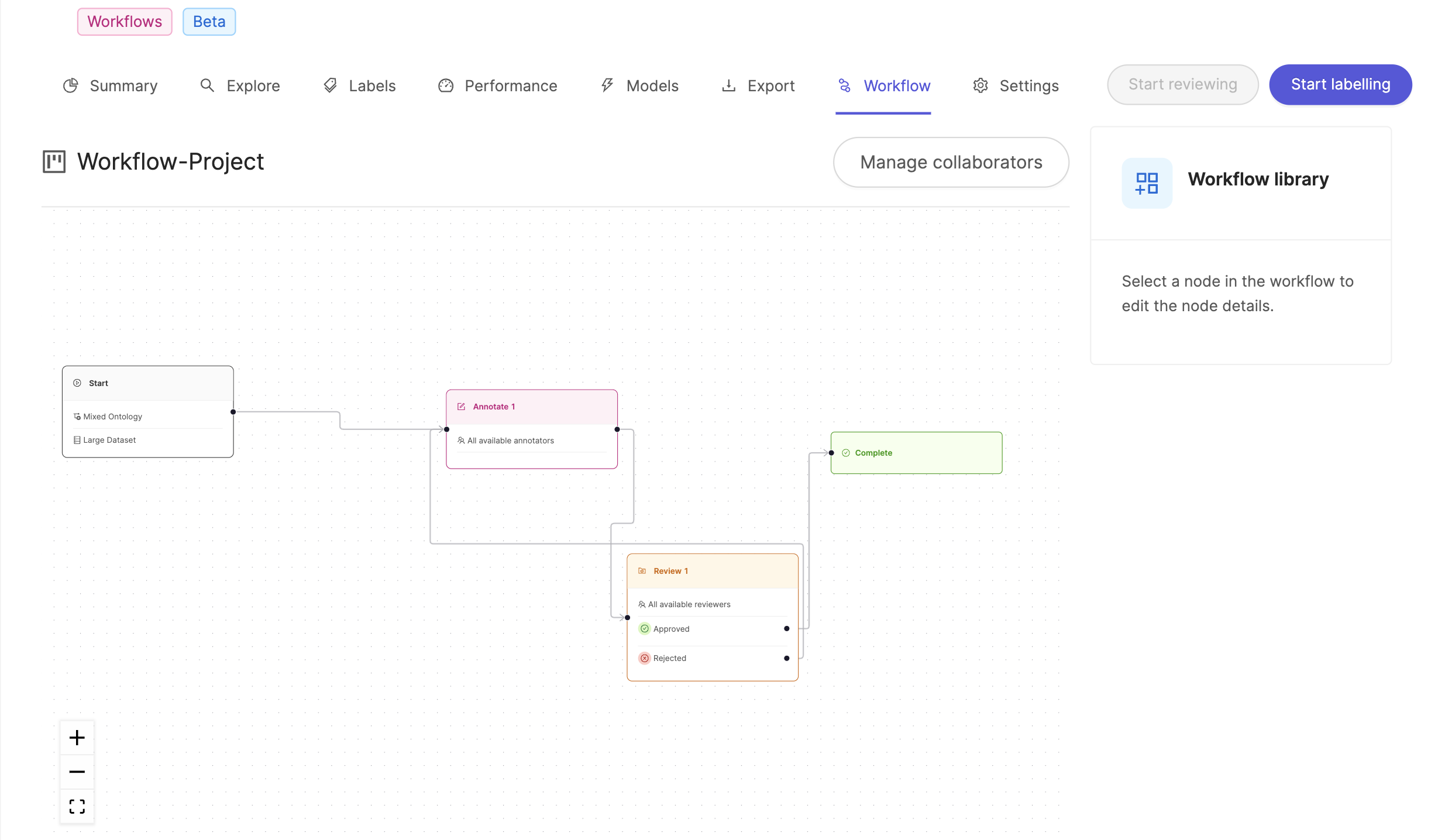
While nodes can't be edited within a project, edits can be made to a workflow template. Click here to learn how to do this.
Adding and editing webhooks
You can edit the webhook URL of Annotate and Complete stages. Click the stage on the canvas and click the + icon next to 'Webhook' to add the URL of the server you would like to receive notifications on.
Manage project collaborators
You can manage the project collaborators by clicking the Manage collaborators button. To learn the details of managing collaborators on the project level, please see our documentation here.
Manage workflow stage collaborators
Collaborators at individual workflow stages and routers can be added and removed by clicking the component on the canvas. Click on the links below to learn the details of adding or removing collaborators at each stage.
Settings
The 'Settings' tab allows you to make modifications to your project using the following tabs:
- Options - Copy a project, modify datasets, modify ontology, upload annotation instructions, modify project tags, QA settings.
- Team - Manage collaborators on a project.
- Danger zone - Delete your project.
Options
Modify datasets, modify project tags, modify ontology, upload annotation instructions, and copy your project.
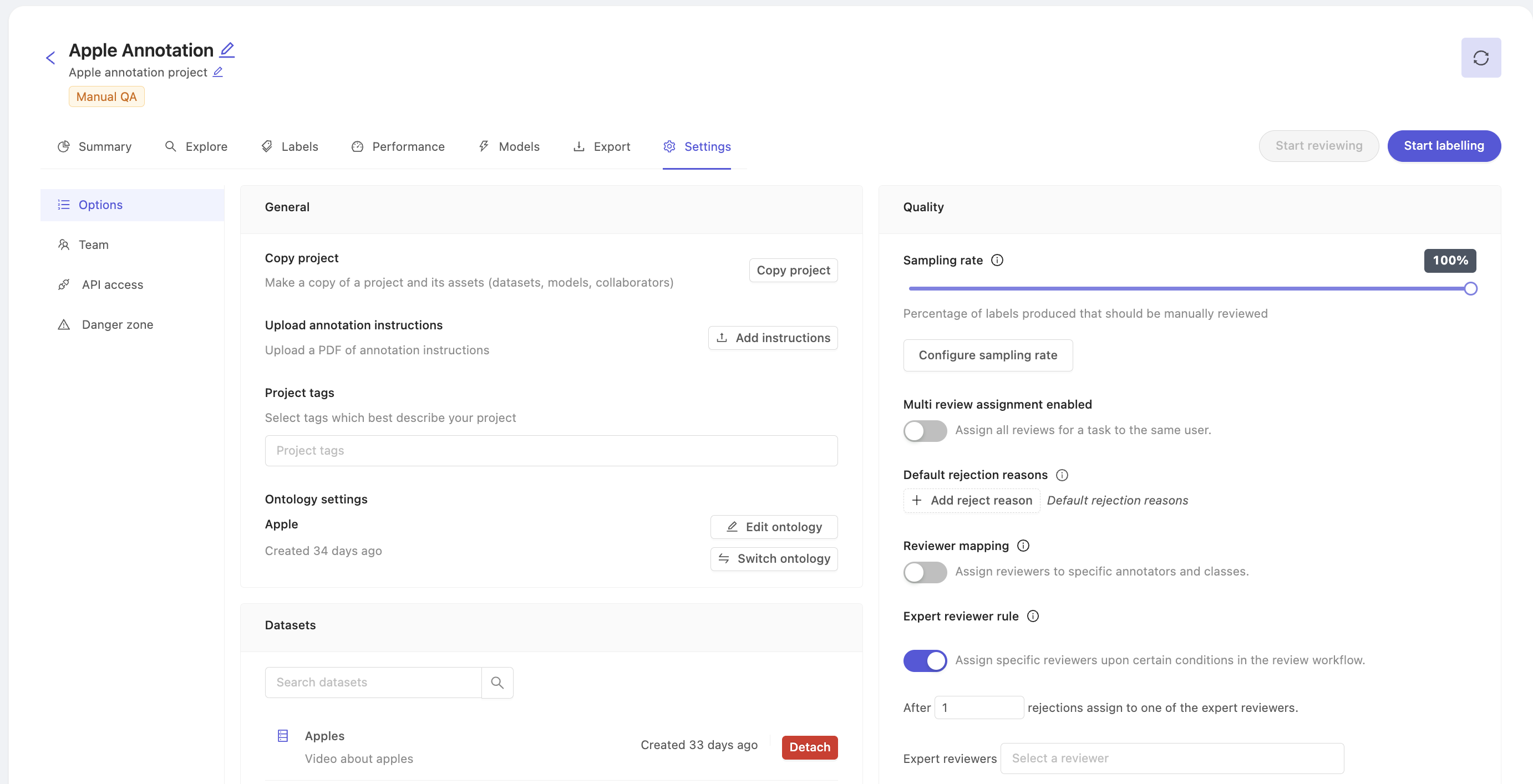
Upload annotation instructions
Click the Add instructions button to upload instructions for your annotators in PDF format.
To ensure the best possible results, provide as much detail as possible about what you would like annotated and how precise bounding boxes should be drawn. For example, instead of saying 'person', consider defining what should constitute a person for your annotators - only a full person? A torso? Or should any part of a person in a frame be labeled as a 'person'?
The more specific your annotator instructions, the higher the chances that your annotators will perform well.
- Once uploaded, annotation instructions will be accessible within the Label Editor, or the Workflows tab.

Project tags
Tags are created and managed on the Organization level. Once created they can be added to individual projects.
You can add tags to a project if you are part of an organization. Project tags allow you to:
Flexibly categorize and group your projects.
Filter your projects.
Adding and removing tags
You can add tags to your projects in:
When creating a project.
In the 'Settings' page of a project. This process is described below.
To add tags to your projects in the 'Settings' page, navigate to the 'Options' tab and click the 'Project tags' dropdown. Here you will see the available tags in your organization. Click on a tag to add it to a project. You can remove a tag from your project by clicking the same tag again, or clicking the x button next to its name.
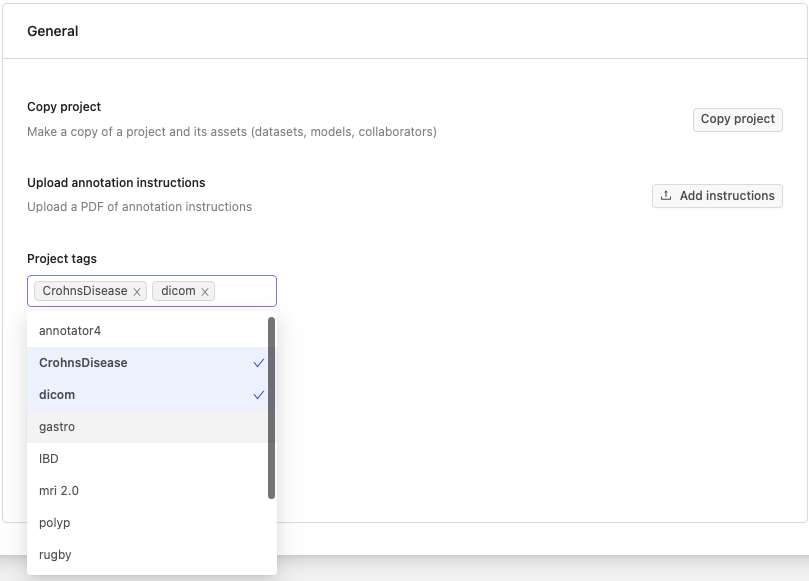
Filtering projects by tags
You can filter your projects based on the tags they contain. To do so, click on the 'Projects tab' in the Navigation bar, click the 'Filter by tags' dropdown and select one or more project tags. This will result in only projects with the tags being selected being displayed.
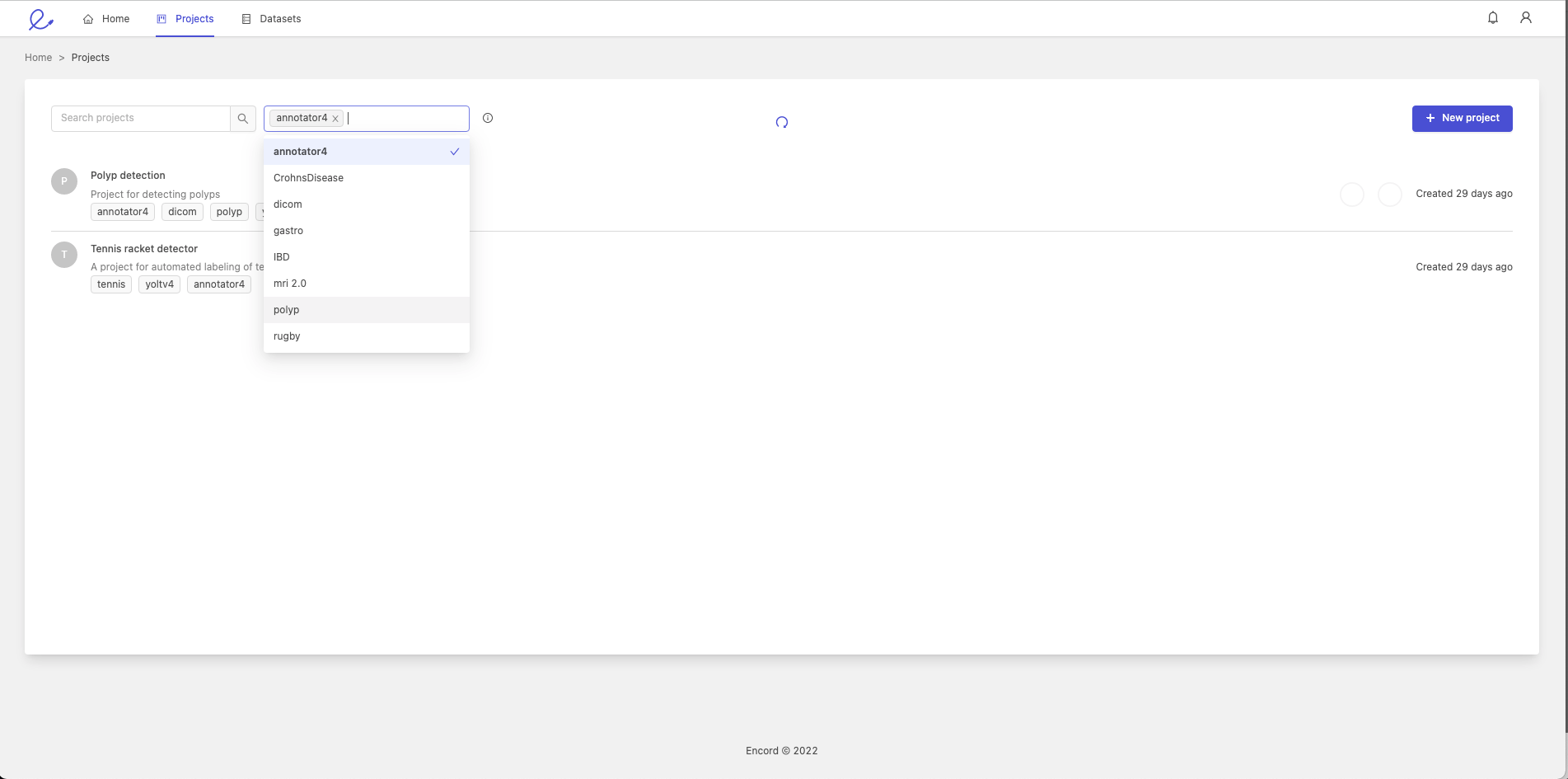
Edit project ontology
You can view or switch the ontology attached to your project.
Changing the ontology can render existing labels invalid and lead to data inconsistency.
Click the Switch ontology button to switch the ontology linked to your project. The resulting pop-up allows you to choose an existing ontology from a list, or create a new ontology for this project.
Click the View ontology button to view the details of the ontology that is attached to the current project.
Edit datasets attached to a project
The 'Datasets' section allows you to attach or detach any number of datasets to your project by clicking Manage.
You will have to create a new dataset in the 'Datasets' section for it to become available in a project's settings.
Copy a project, modify datasets, modify ontology, upload annotation instructions, modify project tags, QA settings.

Copy a project
To copy a project, click on the Copy project button in the 'Options' tab under 'Settings'. This will open the copy project window, where you can pick the various parts of your project you want to copy over into your new project.
1. Select copy options
Choose the parts of your project you want to copy.

You can copy any combination of the following assets:
- Labels: this will copy the labels within videos and image groups of your choice.
- Models: this will copy all the models in your project along with their training logs.
- Collaborators: this will copy the collaborators assigned to individual workflow nodes. Project admins will be copied regardless of whether or not this option is selected.
- All datasets: all datasets will be copied, and new annotation tasks will be created for all videos and image groups if their labels were not copied over (see next line).
The new annotation project will use the same ontology as the original. This can be changed in the project settings if required.
If you don't want to copy labels, press Copy project. This will create the copy of your project, which you can then access in the 'Projects' tab.
If you choose to copy over labels, you will be asked to select the data assets for which you would like labels copied over. To begin the process, press Next: configure labels. Continue to step 2. below.

2. Select data assets
Select the files whose labels you want to copy over. After doing so, click Next.
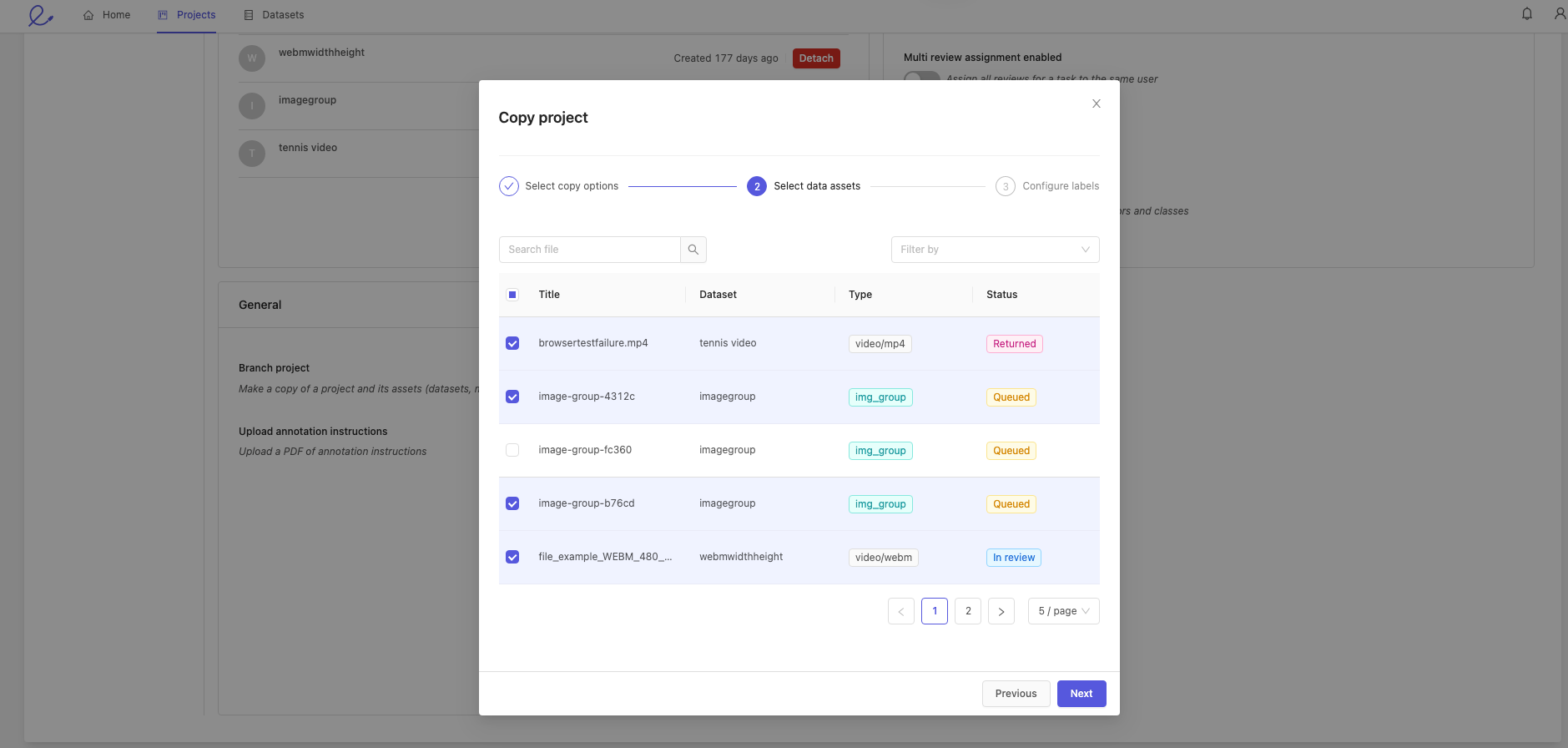
3. Configure labels
Select the statuses of the files you want copied over into your new project.
Click the Copy project button to complete the process.
Label Editor
Projects created using Workflows include some minor changes to the label editor.
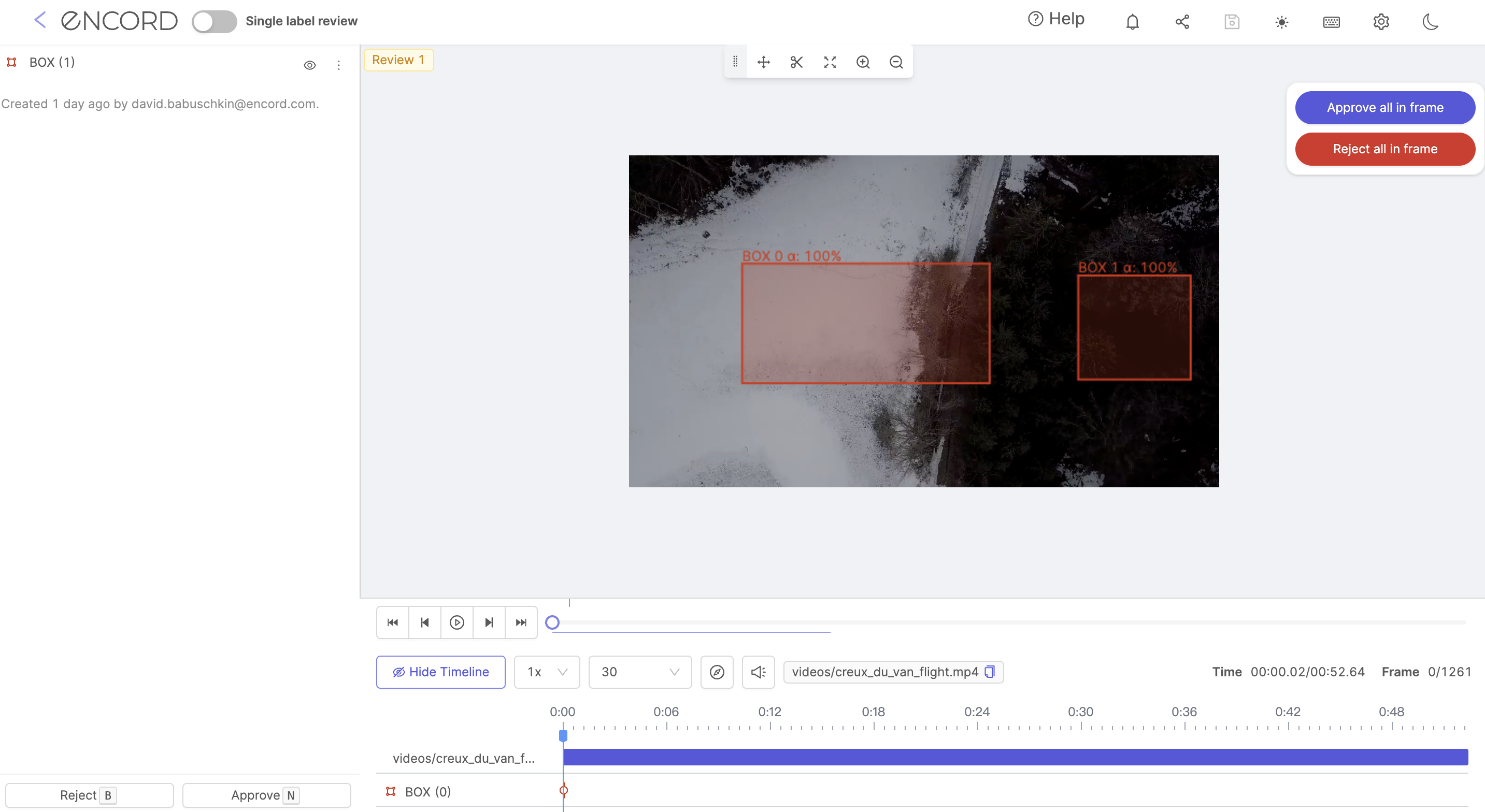
In Annotation as well as Review stages the current workflow status is displayed in the top left corner of the label editor.
The Edit labels and Report missing labels buttons have been removed, and this functionality is not supported for projects created using 'Workflows'.